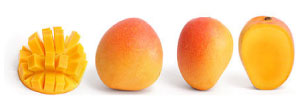
The mango is a fleshy stone fruit belonging to the genus Mangifera, consisting of numerous species of tropical fruiting trees in the flowering plant family called Anacardiaceous. While other Mangifera species (e.g. M. foetida) are also grown on a more localized basis, Mangifera Indica – the common mango is the only mango tree commonly cultivated in many tropical and subtropical regions, and its fruit is distributed essentially world-wide.
In several cultures, its fruit and leaves are ritually used as floral decorations in weddings and public celebrations and religious ceremonies.
The English word “mango” originated, from Malay “mangga”, from Tamil “mankay”.
Mango trees (Mangifera indica L.) grow up to 35–40 m (115–130 ft) tall, with a crown radius of 10 m (33 ft). The mango tree is long-lived, as some specimens still fruit after many years.
The “hedgehog” style is a common way of eating mangoes (left). A cross section of a mango can be seen on the right, not quite fully halving the fruit as the stone is not visible
The ripe fruit varies in size and color. Some are variously yellow, orange, red or green, and carry a single flat, oblong pit that can be hairy on the surface, and which does not separate easily from the pulp. Ripe, unpeeled fruit gives off a distinctive resinous, sweet smell.
Mangoes are widely used in cuisine. Sour, unripe mangoes are used in chutneys, pickles or side dishes, or may be eaten raw with salt (As most Gambians do, especially children, teenagers and pregnant women), chilly or coy sauce. Ripe mangoes are typically eaten fresh; however, they can have many other culinary uses. Mango drink, a popular drink made everywhere is created by mixing ripe mangoes or mango pulp with yogurt and sugar. Ripe mangoes are also used to make curries. The pulp from ripe mangoes is also used to make jam called mango jam. This can be eaten with bread for tea.
Pieces of mango can also be mashed and used as a topping on ice cream or blended with milk and ice as milkshakes. In the
You may want to know that Mango is rich in a variety of phytochemicals and nutrients. The fruit pulp is high in prebiotic dietary fiber, Vitamin C, diverse polyphenols and Provitamin A carotenoids.
Mango contains essential vitamins and dietary meals.
Mangoes account for approximately half of all tropical fruits produced worldwide. The Food and Agricultural Organization of the United Nations estimates worldwide production at nearly 35,000,000 tonnes (39,000,000 short tons) in 2009. The aggregate production of the top 10 countries is responsible for roughly 80% of worldwide production, (Wikipedia, the free encyclopedia).
A cooling summer drink can be made from mangoes and the best time to drink it is now. Now we know a lot can be done with mangoes, so why wait?


